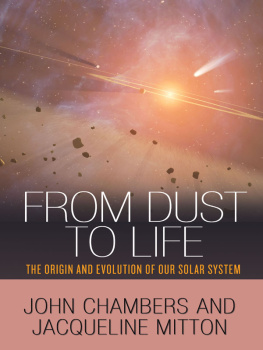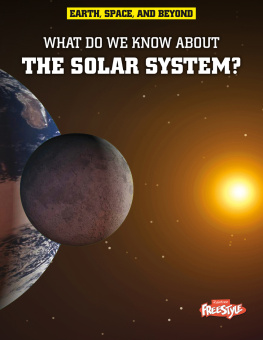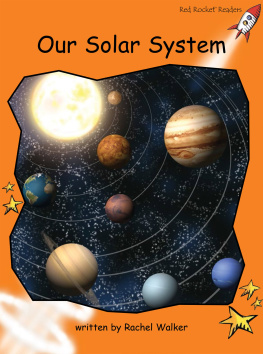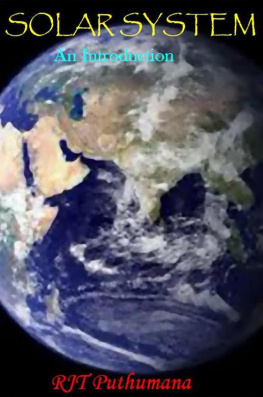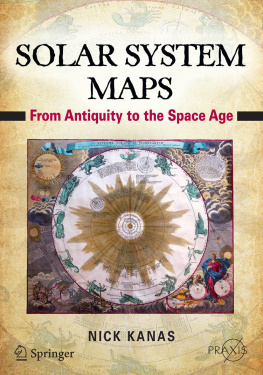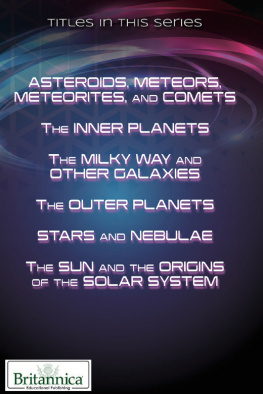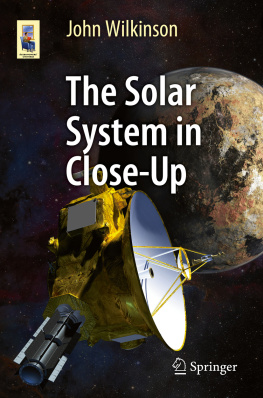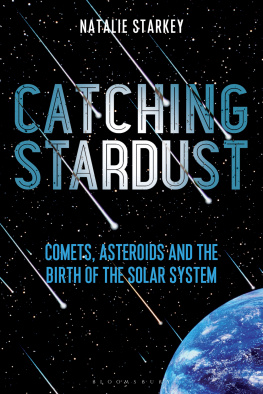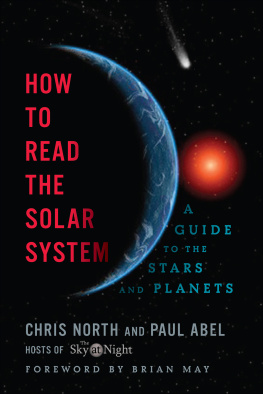
FROM DUST TO LIFE
FROM DUST TO LIFE
THE ORIGIN AND EVOLUTION OF OUR SOLAR SYSTEM

JOHN CHAMBERS AND JACQUELINE MITTON
PRINCETON UNIVERSITY PRESS
PRINCETON AND OXFORD
Copyright 2014 by John Chambers and Jacqueline Mitton
Requests for permission to reproduce material from this work should be sent to Permissions, Princeton University Press
Published by Princeton University Press, 41 William Street,
Princeton, New Jersey 08540
In the United Kingdom:
Princeton University Press, 6 Oxford Street,
Woodstock, Oxfordshire OX20 1TW
press.princeton.edu
All Rights Reserved
ISBN 978-0-691-14522-8
Library of Congress Control Number: 2013944898
British Library Cataloging-in-Publication Data is available
This book has been composed in Minion Pro
Printed on acid-free paper
Printed in the United States of America
1 3 5 7 9 10 8 6 4 2
To Lindsey, Cieran, and Ceinwyn,
for helping to make this possible. JEC

To my husband Simon,
whose love of books and enthusiasm for writing are inspirational. JM
 ILLUSTRATIONS
ILLUSTRATIONS
. | . |
. | . |
. | . |
. | . |
. | . |
. | . |
. | . |
. | . |
. | . |
. | . |
. | . |
. | . |
. | . |
. | . |
. | . |
. | . |
. | . |
. | . |
. | . |
. | . |
. | . |
. |
. | . |
. | . |
. | . |
. | . |
. | . |
. | . |
. | . |
. | . |
. | . |
. | . |
. | . |
. | . |
. | . |
. | . |
. | . |
. | . |
. | . |
. | . |
. | . |
. |
. |
. | . |
. |
. | . |
. | . |
. | . |
. | . |
. | . |
. | . |
. | . |
. | . |
. | . |
. | . |
. | . |
. | . |
. | . |
. | . |
. | . |
 Tables
Tables
 PREFACE
PREFACE
EVERYONE IS FASCINATED BY ORIGINS. We all want to know where we come from, what life was like in the past, how we fit into the larger scheme of things. Each generation has tried to answer these questions in its own way, from mythological creation stories told around the camp-fire to detailed accounts in religious and philosophical texts. In the past few centuries, the rise of the scientific method has provided a new way to think about these age-old questions, offering the possibility of definitive answers for the first time.
The origin, evolution, and nature of our solar systemthe Sun and its family of planets, moons, comets, and asteroidsform a central mystery in the story of our beginnings. Many features of the solar system are essential for sustaining life today, including the longevity and stability of the Sun itself, the existence of water, carbon, nitrogen, and other essential life-building materials, and the size and orbit of Earth, which ensure that our climate is just right for life to flourish and has been so for billions of years. Even the other planets may play a role, helping to supply the raw materials of life to the early Earth, and keeping potentially dangerous impactors at a safe distance. Astronomers have recently found hundreds of other planetary systems in the universe, one of the great discoveries of our time, yet it remains to be seen whether truly Earth-like planets are commonplace or whether a unique series of events during the solar systems formation gave rise to our very special world.
A fascination with the past and the role played by the solar system in determining who we are today provided the motivation for writing this book. Our goal is to tell the story of how the solar system began, as scientists see it, and to describe some key events in its history. At the same time, we look at how scientists have come to appreciate the solar system in all its wondrous detail, how they have slowly pieced together an account of its formation and the timescales involved, and the tools they use to do this.
In our quest, we journey back to the first moments of the universe, when much of its current composition was established, and we examine the solar systems earliest beginnings in the extremely tenuous matter that lies between the stars. We look at the solar nebulathe cloud of gas and dust surrounding the young Sun that formed a nursery for the growing planets. We describe the origin of each of the planets and other members of the solar system, and how they came to be so different from one another.
The pace of scientific progress has increased over time, and the past two decades in particular have seen a flurry of discoveries and breakthroughs. Inevitably, some gaps in our knowledge remain, and some scientific theories that hold sway today may fall by the wayside tomorrow. Science has a direction, however. New discoveries build upon the work of earlier generations, typically adding to this work rather than demolishing it. Even when a major revolution takes place, its pillars almost always rest on earlier foundations. The rapid recent pace of discovery makes now a good time to take stock of the current situation. While some of the details may change in the coming years, there is every reason to believe that many of the key concepts we describe in this book will survive the passage of time.
Next page
